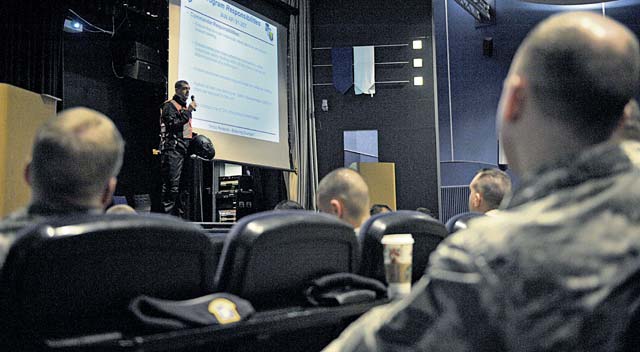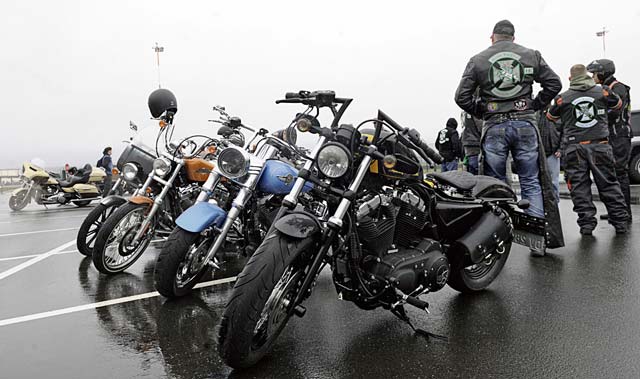
As the year rolls into spring, so too will many of the motorcycle riders in the KMC as they come out to enjoy a ride in the warmer weather.
In preparation for the increased presence of riders, the 86th Airlift Wing Safety office held a preseason motorcycle-safety briefing April 1 on Ramstein.
The briefing is an annual requirement for motorcycle riders and is used as a way to get them back into the right mindset as many of them shake off the dust that may have gathered during the colder months of not riding.
“Ten percent of the (Department of Defense) — Airmen, Soldiers, Sailors, Marines — ride motorcycles, but they historically account for approximately 50 percent of the traffic-related fatalities,” said Robbie Bogard, 86th Airlift Wing Safety Occupational Safety and Health Administration manager. “Because of that, since the mid-1980s the DOD and all the component services have offered different types of training at government expense to arm them with the skills they need to prevent them from being in mishaps.”
While motorcycle accidents don’t necessarily happen more often than other vehicle accidents, death is a greater possibility due to the vehicle providing less protection to the operator.
Because of this, the Department of Defense requires military members to be trained and given knowledge to better protect themselves so they can enjoy their rides safely.
The briefing presented information about being in the right mindset, safety measures to keep in mind, and road and motorcycle etiquette, amongst other things.
“As a motorcyclist, you are more vulnerable,” Bogard said. “Because you are more vulnerable, you need to take more steps to protect yourself. … If you’re not in the right mindset and you don’t respect the power your machine is capable of putting out, you can find yourself in harm’s way.”

According to Bogard, the majority of motorcycle accidents involve one vehicle and are caused by operator error. However, automobile operators can help keep motorcyclists safe by keeping an eye out for the smaller vehicles.
The safety office also spoke about the benefits of finding a mentor rider or a club with which to ride.
“We’re presenting information to help, but ultimately it’s up to the individual to keep themselves safe,” said Senior Master Sgt. Shuntesia Dupree, 86th AW Safety superintendent. “Mentor rides help because a more experienced rider may see you do something dangerous and warn you of it or they can just give you advice to be safer in general.”
To further give this idea some weight, the 86th AW Safety office scheduled two group rides — one for sport bikes and one for nonsport bikes — for those people who wanted to and could participate after the briefing.
The briefing was open to all DOD members in the KMC, including those individuals who are potential motorcyclists. More than 200 riders and potential riders showed up to the briefings, but that was still less than half of the nearly 500 KMC motorcyclists expected to hit the road this season.
For those that missed the briefing, the slides will be provided to commanders and unit motorcycle-safety representatives.
For potential riders, the briefing was just the first step to being authorized to ride as a military member.
To get a motorcycle endorsement on a U.S. Forces Certificate of License, members must possess a valid stateside motorcycle license and have taken the Basic Rider Course 1, a two-day training course designed to teach new riders the basics of motorcycle operations.
Between six months to a year after taking BRC 1, riders must also take intermediate training, which is either BRC 2, Advanced Rider Course or Military Sport Bike Rider Course. These one-day classes aim to teach or refresh knowledge on more advanced techniques.
BRC 2 and ARC are geared toward nonsport bike riders, and MSRC is specifically for sport bike riders.
These classes don’t happen without instructors, so the 86th AW Safety office is looking to replace the 32 percent of their rider coaches they have lost.
To be a rider coach, members must get their commander’s approval. They must be a frequent rider with a clean driving record, willing to be a role model for less experienced riders, be able to teach at least two training classes, can dedicate two weeks away from work for the Basic Rider Trainer workshop, and have at least two years left on station.
“That’s the most important part,” Dupree said. “We pay to make sure you are properly trained, and we want to keep you around to keep our riders safe.”


